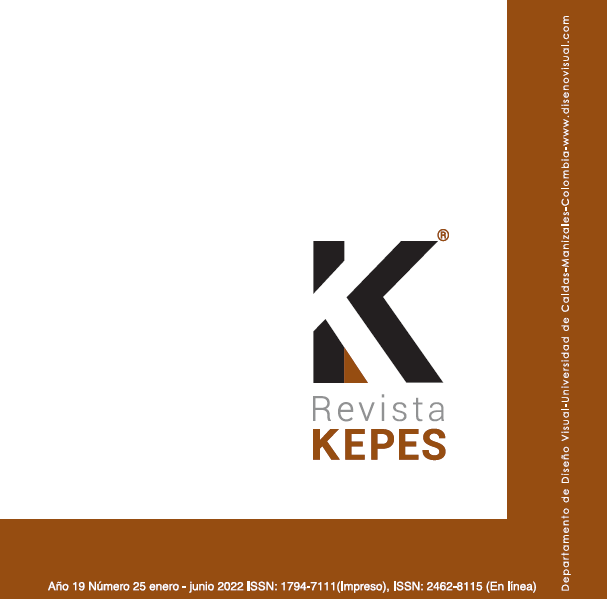Authors
Abstract
Some actions, inherent to the teaching of design within the framework of an educational experience analyzed from the project practice in subjects of the undergraduate Visual Design Program at Universidad de Caldas, are documented in this article. The teaching experience resulting from implementing classroom projects is exposed, an experience that, during 10 years (2008-2018) of work, has linked communities and city projects with the undergraduate Program. The value of contact with real problems in the comprehensive training of designers is highlighted, giving the possibility of proposing and planning didactic actions that lead to the improvement of the experience of project practice in some subject areas. Here arises the need to deepen the pedagogical planning to detect the characteristics that the didactic actions must present and thus to understand how to approach them from design through an observation mediated by qualitative methodological approaches. The article reports how some professors of this undergraduate Program have designed subject content and have proposed suitable scenarios for experimentation, giving space to the development of initiatives such as LEDI Laboratorio Estratégico de Diseño Integral (Strategic Integral Design Laboratory), which complements the academic scenario and emphasizes a comprehensive vision of design.
Documentation of some processes and projects arises in this reflection on the teaching practice, from which the interest arises to propose the conscious and contextualized construction of the courses under the disciplinary perspective of education due to the need to identify how contents, both theoretical and practical, of some subjects of the Design Programs are oriented and add to the educational strategy the possibility of accessing professional spaces that can be managed by professors, and that students can access from the university and get the best out of this experience, as well as reflecting the harmony of the solutions planted from the academy with the detected needs of the context where the education process influences, in this case, the undergraduate Program in Visual Design and highlights the importance of understanding the social spaces where in-training designers act and bring them closer to them.
Keywords:
References
Ambrose, G. y Harris, P. (2010). Metodología del diseño. Parramón.
Archer, L. B. (1964). Systematic Methods for Designer. Council of Industrial Design.
Asimov, M. (1970). Introducción al proyecto. Editorial Herrero Hnos. Sucs.
Brown, T. (2009). Change by Design: how Design Thinking Transforms Organizations and Inspire Innovation. Harper Business.
Chaves, N. (1988). La imagen corporativa. Teoría y metodología de la identificación institucional. Gustavo Gili.
Cloninger, C. (2007). Hot-wiring your creative process. Strategies for print & media designers. New Riders.
Creswell, J. (1998). Qualitative inquiry and research design. Choosing among five traditions. Sage.
Cross, N. (2012). Métodos de Diseño. Estrategias para el Diseño de Productos. Limusa Wiley.
Davis, M. (2016). Normal Science’ and the Changing Practices of Design and Design Education. Visible Language, 50(1).
Díaz, G., Mendoza, Y. y Escorcia, S. (2021). Transposición didáctica y la perspectiva crítica de Pablo Freire. Encuentros. Revista de Ciencias Humanas, Teoría Social y Pensamiento Crítico, 1(13), 168-176.
Frascara, J. (2006). El diseño de comunicación. Edición corregida y extendida de Diseño Gráfico y Comunicación. Ediciones Infinito.
Fundación Nutrir. (2021). ¿Quiénes somos? https://nutrirong.com/quienes-somos/
González, E. (1994). El proceso de creación y la evolución de los proyectos de diseño gráfico. Servicio Editorial Universidad del País Vasco. Hernández, R., Fernández, C. y Baptista, P. (2014). Metodología de la investigación (6a. Ed.). McGraw-Hill.
Jones, J. C. (1976). Métodos de diseño. Gustavo Gili.
Lauer, D. A. (1979). Design Basics. Holt, Rinehart and Winston.
Lave, J., & Wenger, E. (1991). Situated Learning: Legitimate Peripheral Participation. Cambridge University Press.
Lawson, B. (2005). How Designers Think. The Design Process Demystified. Architectural Press.
Loaiza, Y. (2019). Las prácticas pedagógicas en el campo de la educación: su confluencia en investigaciones de posgrado de la UCM. Revista de Investigaciones UCM, 19(33), 49-63.
Londoño, F. (2014). Plan de Acción Institucional de la Universidad de Caldas, “Universidad y Pensamiento Crítico 2014-2018”. Universidad de Caldas. http://www.ucaldas.edu.co/portal/wp-content/uploads/2014/12/PAI_Plan_Accion_Institucional_Rectoria_2014_2018.pdf
López, A. M. y Tamayo, Ó. E. (2012). Las Prácticas de laboratorio en la enseñanza de las ciencias naturales. Revista Latinoamericana de Estudios Educativos, 8(1), 145-166.
Moles, A. y Caude, R. (1977). Creatividad y métodos de innovación. Ibérico Europea de Ediciones.
Mollerup, P. (1987). El programa de diseño corporativo. IMPI/MINER Ediciones de Diseño. Fundación BCD Barcelona.
Munari, B. (1981). ¿Cómo nacen los objetos? Apuntes para una metodología proyectual. Gustavo Gili.
Ortega-Díaz, C. y Hernández-Pérez, A. (2015). Hacia el aprendizaje profundo en la reflexión de la práctica docente. Ra Ximhai, 11(4), 213-220.
Plan Institucional de Actividad Académica. (2015). PIAA. Diseño Integral.
Radio Nacional de Colombia. (2014). Visual Rock: proyección audiovisual para las bandas manizaleñas. https://www.radionacional.co/noticia/visual-rock-proyeccion-audiovisualpara-las-bandas-manizalenas
Ricard, A. (2008). Conversando con estudiantes de diseño. Gustavo Gili.
Rodríguez, L. (2006). Diseño: estrategia y táctica. Siglo XXI.
Rodríguez, L. (2011). Interdisciplina en diseño: un reto para la docencia. Diseño sin fronteras. IV Congreso Internacional de Diseño. México 26-28 de octubre 2011. http://www.dis.uia.mx/conference/2011/LibroMX2011.pdf
Tobón, S., Pimienta, J. y García, J. (2010). Secuencias Didácticas: aprendizaje y evaluación de competencias. Pearson-Prentice Hall.
Wenger, E. (1998). Communities of Practice: learning, meaning and identity. Cambridge University Press.
Zabala, A. (2000). La práctica educativa. Cómo enseñar. Graó.

 pdf (Español (España))
pdf (Español (España))
 FLIP
FLIP
 Perfil Google Scholar
Perfil Google Scholar


















